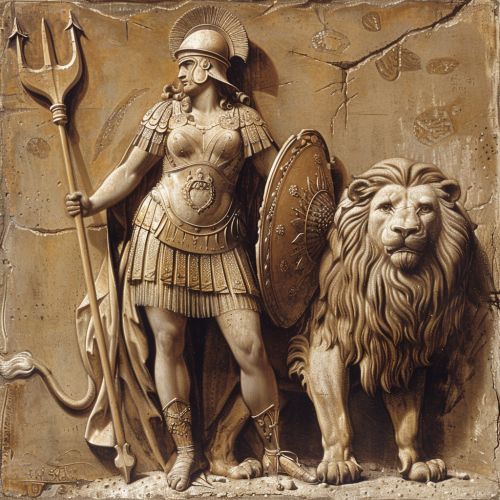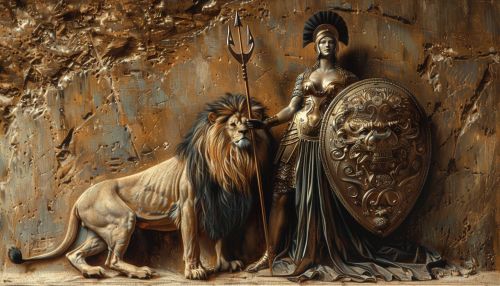Britannia: Difference between revisions
(Created page with "== Introduction == '''Britannia''' is a national personification of the United Kingdom, originating from Roman Britain. The term has evolved over centuries, symbolizing the British Isles and the British Empire. This article delves into the historical, cultural, and symbolic significance of Britannia, examining its origins, evolution, and contemporary relevance. == Historical Origins == === Roman Britain === The concept of Britannia dates back to the Roman conquest of...") |
No edit summary |
||
| Line 19: | Line 19: | ||
In the 18th century, Britannia became a central figure in British iconography. She appeared on coinage, official documents, and artworks, often depicted with a lion, symbolizing strength and courage. The [[Union Jack]] and the [[Royal Navy]] were frequently incorporated into her imagery, emphasizing Britain's growing imperial ambitions. | In the 18th century, Britannia became a central figure in British iconography. She appeared on coinage, official documents, and artworks, often depicted with a lion, symbolizing strength and courage. The [[Union Jack]] and the [[Royal Navy]] were frequently incorporated into her imagery, emphasizing Britain's growing imperial ambitions. | ||
[[Image:Detail-91899.jpg|thumb|center|Classical depiction of Britannia as a helmeted female warrior with a shield and trident, standing beside a lion.|class=only_on_mobile]] | |||
[[Image:Detail-91900.jpg|thumb|center|Classical depiction of Britannia as a helmeted female warrior with a shield and trident, standing beside a lion.|class=only_on_desktop]] | |||
== Symbolism and Iconography == | == Symbolism and Iconography == | ||
Latest revision as of 03:21, 19 June 2024
Introduction
Britannia is a national personification of the United Kingdom, originating from Roman Britain. The term has evolved over centuries, symbolizing the British Isles and the British Empire. This article delves into the historical, cultural, and symbolic significance of Britannia, examining its origins, evolution, and contemporary relevance.
Historical Origins
Roman Britain
The concept of Britannia dates back to the Roman conquest of Britain in AD 43. The Romans referred to the island as "Britannia," and it was personified as a goddess. The earliest depictions of Britannia appeared on Roman coins, where she was shown as a helmeted female warrior, often accompanied by a shield and trident. This imagery symbolized the strength and maritime prowess of the Roman province.
Post-Roman Period
After the fall of the Roman Empire, the figure of Britannia faded from prominence. However, the name persisted in various forms, such as in the works of medieval chroniclers like Geoffrey of Monmouth, who linked the term to the legendary King Arthur and the ancient Britons.
Renaissance and Revival
16th and 17th Centuries
The Renaissance period saw a revival of classical imagery, including Britannia. During the reign of Queen Elizabeth I, Britannia re-emerged as a symbol of national identity and maritime power. The defeat of the Spanish Armada in 1588 further solidified Britannia's association with naval dominance.
18th Century
In the 18th century, Britannia became a central figure in British iconography. She appeared on coinage, official documents, and artworks, often depicted with a lion, symbolizing strength and courage. The Union Jack and the Royal Navy were frequently incorporated into her imagery, emphasizing Britain's growing imperial ambitions.


Symbolism and Iconography
Attributes
Britannia is traditionally depicted as a young woman wearing a Corinthian helmet and white robes. She often holds a trident, representing her dominion over the seas, and a shield emblazoned with the Union Jack. The lion at her side symbolizes bravery and strength. These attributes collectively convey the themes of protection, maritime power, and national pride.
Evolution of Imagery
Over time, Britannia's imagery has evolved to reflect contemporary values and political contexts. During the Victorian era, she was often portrayed as a matronly figure, embodying the moral virtues of the British Empire. In the 20th century, her image was adapted to suit modern sensibilities, appearing in various media, from propaganda posters during the World Wars to contemporary art and popular culture.
Cultural Significance
Literature and Art
Britannia has been a recurring motif in British literature and art. Poets like John Milton and William Blake have invoked her in their works, while artists such as James Gillray and George Cruikshank have used her image in political cartoons. Her presence in these mediums underscores her role as a symbol of national identity and political commentary.
Music and Theatre
In music and theatre, Britannia has been celebrated in patriotic songs like "Rule, Britannia!" and depicted in theatrical productions and pageants. These performances have reinforced her status as a cultural icon, embodying the spirit of the nation.
Contemporary Relevance
Modern Depictions
In contemporary times, Britannia continues to be a potent symbol of British identity. She appears on the reverse of British coins and is featured in various forms of media. Her image has been adapted to reflect modern values, such as diversity and inclusivity, while retaining her historical attributes.
Political Symbolism
Britannia's image has also been used in political discourse, representing different aspects of British society and governance. She has been invoked in debates on national sovereignty, particularly in the context of Brexit, where her image has been used to symbolize both the strength and challenges of the United Kingdom.
Conclusion
Britannia remains a powerful and enduring symbol of the United Kingdom. Her evolution from a Roman personification to a modern icon reflects the changing values and aspirations of British society. As a representation of national identity, maritime power, and cultural heritage, Britannia continues to inspire and resonate with the British people.
